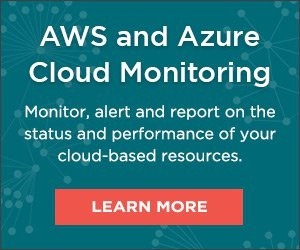In 2018, it’s pretty obvious that Larry Ellison was wrong. The cloud is here to stay, so you'd better understand it, if you don't already.
But the jargon and terminology surrounding the cloud can be overwhelming. It’s a lot to keep up with, especially with the pace of innovation in modern tech. In fact, the only thing outpacing the rate of innovation in tech is the rate of new jargon being innovated, iterated, pivoted, and synergized by the rockstars/ninjas/gurus in marketing.
So with that in mind, here are some of the top terms and acronyms covering key cloud computing concepts. And don’t worry, it’s scalable. We’ll add new terms and definitions as they come up, so if there’s anything you need help with, or would like to see added, don’t hesitate to ask in the comments.
Amazon Web Services (AWS) –
The world most widely-used cloud service provider. Amazon Web Services (AWS) is Amazon Inc.’s bundle of more than 36 cloud computing services, including PaaS, SaaS, and IaaS offerings. AWS currently holds over 30% of global cloud computing market share.
Cloud Computing – In the simplest terms possible, cloud computing is the delivery of information technology services or resources via a network, rather than from on-premise hardware and resources. As you’ve probably already surmised, 99% of the time, that delivery network is the internet.
According to the official definition from the NIST, there are five main components of cloud computing: on-demand self-service, broad network access, resource pooling, rapid expansion (typically referred to as elasticity), and measured service.
Essentially, a cloud provider works like a utility company (think electric or water)—they host the resources or services that you need, and deliver them on-demand, scaling up or down to suit your needs.
Cloud Management Platform (CMP) – A cloud management platform allows integrated management of private, hybrid, and public clouds.
Cloud Marketplace – Cloud marketplaces are online stores where customers can explore and subscribe to software applications and developer services that supplement, integrate into, or build on top of existing software. Amazon’s AWS Marketplace is a good example.
Cloud Migration – The process of moving applications, services, and data from on-premise to the cloud. This has become big business as many large enterprises struggle to migrate their data and deployments to cloud workloads.
Cloud Monitoring – The process of reviewing and managing the operational workflow and processes within a cloud infrastructure or asset. It’s generally implemented through automated monitoring software that gives central access and control over the cloud infrastructure. Admins can review operational status and health of cloud devices and components. For more information, check out our post What is Cloud Monitoring?
Cloud Service Provider (CSP) – A cloud service provider is—you guessed it—any company that sells a cloud computing service, be it PaaS, IaaS, or SaaS.
Cloud Storage – A method of computer storage where data is stored in facilities managed by a cloud service provider and can be accessed remotely by the user through a network. Typically, data stored in the cloud is collocated, which means it is duplicated in multiple locations as a failover.
Container – A virtualization instance where the kernel of an operating system allows for multiple isolated user-space instances. While virtual machines (VMs) need to run a full operating system (OS) image for each instance, containers do not. Instead, they create an isolation boundary at the application level. The benefits of this are multi-fold. First, if a something goes awry in a single container, only that container is affected, rather than the entire VM. Second, the application-level isolation boundary prevents compatibility issues between applications running on the same operating system.
DevOps – An abbreviation of “development and operations,” DevOps is the combination of tasks performed by applications development and systems operations teams. DevOps as a method of software development emphasizes communication, integration, and collaboration between developers and IT people to streamline the software development, delivery, and support processes and improve product quality.
Elasticity – The ability of a system to adapt to a shifting workload demand by provisioning and de-provisioning pooled resources to match current demand as much as possible.
Extensibility- The ability to add new functionality and framework support.
Google Cloud Platform (GCP) – Google’s cloud services offering, Google Cloud Platform (GCP) has both infrastructure as a service (IaaS) and platform as a service (PaaS) products.
Host Machine – The physical hardware (i.e., Server) that stores virtual machines or containers.
Hybrid Cloud – A cloud computing environment made up of a combination of private and public clouds, as well as on-premises solutions. Private and public cloud infrastructures stay distinct from one another, but the hybrid cloud ensures data and services portability by binding them together without sacrificing their integrity.
Hypervisor – A hypervisor, which creates, runs, and manages virtual machines (VMs) is also called a virtual machine monitor (VMM). It is a piece of software that allows physical devices to share resources among virtual machines supported by physical hardware.
Infrastructure – IT infrastructure is the combined hardware and virtual resources that support an overall IT environment.
Infrastructure as a Service (IaaS) – A model of cloud computing where the vendor hosts and provides to its customers compute resources, as well as networking and storage capabilities.
Instance – An instance is a single virtual machine or server supporting a workload. Most cloud platforms allow users to choose from several instance types to determine the hardware that hosts the instance.
Load Balancing – The process of distributing computing workloads across multiple resources, including servers. A load balancer in cloud computing acts as a reverse proxy and distributes application traffic to several different servers to prevent any single application server from being overwhelmed and becoming a point of failure.
Microsoft Azure – Microsoft Azure, formerly known as Windows Azure, is Microsoft’s cloud computing platform. Initially, Azure only offered a PaaS solution, but now it provides both PaaS and IaaS options.
Middleware – Software that connects different kinds of software components or enterprise applications.
Multi-Cloud – The concurrent use of separate cloud service providers for different infrastructure, platform, and software uses. A multi-cloud strategy can help prevent vendor lock-in, as well as increasing the ability of an enterprise to handle diverse workloads and partners. However, using a multi-cloud approach can complicate processes such as security and governance.
Multi-Tenancy – A mode of operation for software, wherein multiple instances of one or more applications run in a shared environment. In a cloud computing model, pooled virtual and physical resources are dynamically assigned and reassigned to tenants (groups of users) to keep up with consumer demand.
On-Demand Self Service – A service model that lets a customer provision and deploy additional cloud resources on-demand, usually through an online control panel, without involving the service provider.
Platform as a Service (PaaS) – A model of cloud computing where a vendor provides, as a service, the hardware and software tools to create, deploy and manage applications at scale to the user through the internet.
Private Cloud – A cloud infrastructure that is provisioned for use by a single organization. A private cloud cab can exist on or off premises and is managed and operated by either the organization, a third party, of some combination of both.
Public Cloud – A cloud infrastructure that is hosted by cloud services provider and made available to the public through the internet.
Scalability – The ability of a process, system, or framework to handle a growing workload. A scalable system is adaptable to increasing or changing demands.
Software as a Service (SaaS) – A model of cloud computing where applications and software are hosted by a vendor that provides them to the user as a service. SaaS applications are licensed on a subscription basis.
SaaS has become a popular model of delivery for business applications because they can be accessed in any location, at any time, and on any platform. Microsoft’s Office 365, which houses web-based email and productivity software including MS Word and Excel as services, is an example of a popular SaaS application.
Virtual Machine (VM) – A software emulation of a computer system that provides all of the functionality of a physical computer. VMs are used to run multiple instances of the same operating system on a single server.
Workload – The amount of work running on an instance.

